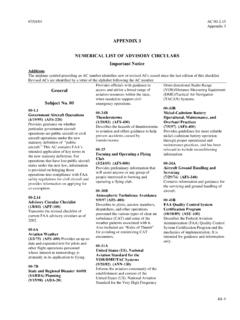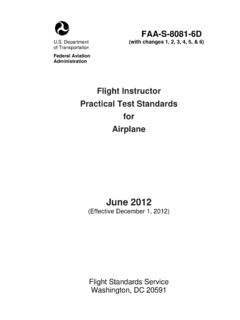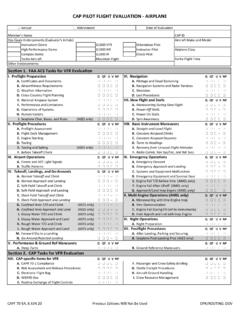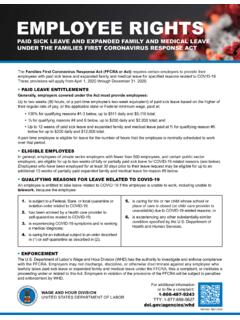Transcription of Certificated Flight Instructor Preparation Guide
1 Contents PageSection 1 - General 1-1 Introduction 1-1 The Players 1-1 The Student 1-1 The Student's Instructor 1-1 The FAA Inspector 1-2 The CFI PTS 1-2 The Practical Test 1-3 Reference Material 1-4 Preparing for the Practical Test 1-6 The Flying Portion of the Practical Test 1-8 Flow to Use This Guide 1-9 Step 1 1-9 Step 2 1-10 Step 3 1-10 Section 2 - Area of Operation I, Fundamentals of Instructing 2-1I. Fundamentals of Instructing 2-4A. The Learning Process 2-4B. Human Behavior and Effective Communication 2-6C. The Teaching Process 2-8D. Teaching Methods 2-10E. Critique and Evaluation 2-12F. Flight Instructor Characteristics and Responsibilities 2-14G.
2 Planning Instructional Activity 2-17 Section 3 - Areas of Operation II and III, Technical Subject 3-1 Areas and Preflight PreparationII. Technical Subject Areas 3-3A. Aeromedical Factors 3-3B. Visual Scanning and Collision Avoidance 3-6C. Principles of Flight 3-9D. Airplane Flight Controls 3-12E. Airplane Weight and Balance 3-13F. Navigation and Flight Planning 3-16G. Night Operations 3-20H. High Altitude Operations 3-24I. Federal Aviation Regulations and Publications 3-26J. National Airspace System 3-28K. Navigation Systems and Radar Services 3-31L. Logbook Entries and Certificate Endorsements 3-32 III.
3 Preflight Preparation 3-36A. Certificates and Documents 3-36B. Weather Information 3-39C. Operation of Systems 3-42D. Performance and Limitations 3-44E. Airworthiness Requirements 3-46 ContentsPageSection 4 - Area of Operation IV, Preflight Lesson on a Maneuver 4-1 to be Performed in FlightIV. Preflight Lesson on a Maneuver to be Performed in Flight 4-1A. Sample Whiteboard 4-2A. Sample Lesson Plan 4-3 Section 5 - Areas of Operation V through XIII, Maneuvers 5-1V. Preflight Procedures 5-4A. Preflight Inspection 5-4B. Single-Pilot Crew Resource Management 5-7C. Engine Starting 5-9D. Taxiing - Landplane 5-12G.
4 Before Takeoff Check 5-15VI. Airport Operations 5-19A. Radio Communications and ATC Light Signals 5-19B. Traffic Patterns 5-21C. Airport, Runway and Taxiway Signs, Markings, and Lighting 5-26 VII. Takeoffs, Landings, and Go-Arounds 5-28A. Normal and Crosswind Takeoff and Climb 5-30B. Short-Field Takeoff and Maximum Performance Climb 5-33C. Soft-Field Takeoff and Climb 5-36F. Normal and Crosswind Approach and Landing 5-42G. Slip to a Landing 5-46H. Go-Around/Rejected Landing 5-49I. Short-Field Approach and Landing 5-49J. Soft-Field Approach and Landing 5-55K. Power-Off 180 Accuracy Approach and Landing 5-55 VIII.
5 Fundamentals of Flight 5-63A. Straight-and-Level Flight 5-69B. Level Turns 5-71C. Straight Climbs and Climbing Turns 5-74D. Straight Descents and Descending Turns 5-77IX. Performance Maneuvers 5-80A. Steep Turns 5-80B. Steep Spirals 5-83C. Chandelles 5-86D. Lazy Eights 5-88X. Ground Reference Maneuvers 5-90A. Rectangular Course 5-92B. S-Turns Across a Road 5-95C. Turns Around a Point 5-98D. Eights on Pylons 5-102 Contents PageXI. Slow Flight , Stalls, and Spins 5-106A. Maneuvering During Slow Flight 5-109B. Power-On Stalls 5-112C. Power-Off Stalls 5-115D. Crossed-Control Stalls 5-118E. Elevator Trim Stalls 5-122F.
6 Secondary Stalls 5-124G. Spins 5-126H. Accelerated Maneuver Stalls 5-128 XII. Basic Instrument Maneuvers 5-130A. Straight-and-Level Flight 5-134B. Constant Airspeed Climbs 5-136C. Constant Airspeed Descents 5-139D. Turns to Headings 5-141E. Recovery from Unusual Flight Attitudes 5-143 XIII. Emergency Operations 5-145A. Emergency Approach and Landing 5-146B. Systems and Equipment Malfunctions 5-150C. Emergency Equipment and Survival Gear 5-152D. Emergency Descent 5-153 XIV. Postflight Procedures 5-155A. Postflight Procedures 5-155 Appendix 1. An Example of the First Three Pages, the Task, A 1-1 Strategy, and Reference Materials List Appendix 2.
7 Reference Documents for Fundamentals of Instructing A 2-1 Appendix 3. Reference Material - Logbook Entries and Certificate A-3-1 EndorsementsAppendix 4. Mini Lessons/Special Topics A 4-1 Appendix 5. Flight Check Timetable A 5-1 Appendix 6. Tracking Checklist 16-1 Section 1 GeneralIntroductionThis Guide has been designed to assist anyone involved in Flight Instructor training. It can be used by a perspective applicant preparing for the Flight Instructor certificate. It can be used by the Flight Instructor preparing a prospective Flight Instructor . It is my hope it will be used by FAA Inspectors testing a Flight Instructor idea for this Guide has been floating around in my head for some time.
8 After retiring from the FAA, with just short of 30 years as an Operations Inspector, I decided to teach part-time. My agreement with the owner of the school where I teach is that I could focus my efforts on Flight Instructor students. Between my experience as an Inspector, giving Initial Flight Instructor Flight checks and working with students, it became increasingly obvious that there just wasn't any real hands-on guidance designed to prepare the Flight Instructor more I work with students, the more I find a disconnect between the task of preparing a would-be Flight Instructor and what the Certificated Flight Instructor (CFI) Practical Test Standards (PTS)
9 Is all this Guide also became important to me on a more personal basis, as I realized how far too many of my fellow FAA Inspectors failed to understand the intent of the PTS and how their application of it was inconsistent. In retrospect, that statement is probably an analysis of my own Flight Instructor checkrides as an of preparing a Flight Instructor Student includes making sure that they understand what takes place, who the folks are that they will meet and work with, what they do and do not need to learn, and where they fit into the puzzle. I have also tried to explain how the PTS works and what to expect in the Practical Test.
10 The PlayersPreparing a would-be Flight Instructor is like a three-legged stool. There is a student, there is the student's Instructor and there is the Inspector. If any of the legs isn't holding up its part of the stool, the stool tips Student (aka, the CFI Student, the CFI applicant, the applicant)Let s start with the central figure, the student seeking a Flight Instructor certificate. He is usually under 25 and has around 250 hours total Flight time. His goal isn't usually to become a career Flight Instructor , it's to gain hours and experience to move up in the aviation world. Up until the day the student starts training to become a Certificated Flight Instructor ; he has only been a student learning to fly.





